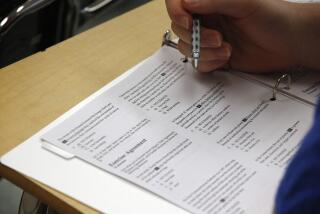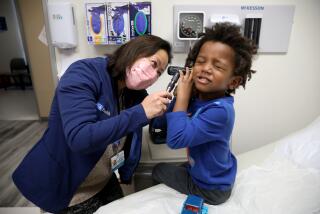For Many Pupils, School Health Exams Can Spell Big Difference for Future
- Share via
The first-grader smiled shyly as school nurse-practitioner Sue Horn measured his height and weight, then asked him to walk and hop along a straight line of masking tape on the floor.
The San Diego city schools nurse measured his difficulty in hopping with one foot along the line, in drawing a circle and square, choosing the colors green and yellow, and in following directions for “above” and “behind.”
Horn completed the hourlong physical exam with an extensive check of his eyes, spine, heart and lungs and the taking of urine and blood samples, at the same time noting the child’s limited vocabulary for his age in responding to simple questions. And all the while, she both tried to reassure the boy’s mother about the problems showing up and to assimilate information the mother was pouring forth, including the fact she was on drugs during the boy’s pregnancy.
Rush to Meet Requirements
Horn and the elementary school’s regular nurse subsequently have scheduled appointments between the boy and school specialists in speech and language, and in special physical education, to draw up plans for helping improve his motor skills and spur overall development. So far, however, they have had less luck in persuading the parents to visit a nearby pediatric clinic for additional medical checks, even
though it would be covered free through their Medi-Cal health eligibility.
Horn, along with colleagues throughout San Diego County and the state, will be extremely busy during the next three months as they scramble to meet requirements of a California state law for all first-graders to receive physical examinations. Countywide, there are more than 37,000 eligible students, with 483,000 across California.
In a majority of cases, parents have already arranged for the exams themselves with their regular pediatricians, who send the results to school nurses and note areas where school specialists can follow up.
But to cover the growing number of cases of families on limited incomes with no medical care--such as the boy examined by Horn the other day--the state provides funds to all county health departments. For smaller school districts such as Oceanside, county health administrators make arrangements with 240 area doctors to perform the physicals. In cases such as the San Diego Unified district, the nation’s eighth largest, the health department contracts with the district’s nursing division. The state spends $86 million annually for its Child Health and Disability Prevention Program.
“Schools try to be forceful on compliance,” but there are no penalties for districts not able to persuade parents to schedule exams, even at no cost, said Phyllis Elkind, who monitors the program in San Diego County. “It depends on both the nature of the student population as well as district commitment . . . the lower figures are generally but not always in areas with higher turnover of kids, with language barriers, and where they are close to the border.”
Unknown Health Problems
Statewide compliance last year was 82.5% of all first-graders, with the county figure slightly below. For individual county districts, percentages ranged from 55.4% in National City, 56.1% in San Ysidro, 61% in San Marcos, 72.7% in Oceanside, 78.6% in San Diego Unified, 86% in Poway, to 100% in Lemon Grove, Rancho Santa Fe and Valley Center.
Statewide, the health screenings find that one in 10 children has an unknown health problem, with the figure 15% in San Diego County, Elkind said.
Of the 20% of students countywide annually whose parents ignore requests for screening, Elkind said they present little if any health risk to the general school population, in large part because the parents must nevertheless have presented proof of required immunizations for acute contagious diseases before enrollment is permitted.
“The (lack of a screening) creates more of an individual problem, in that we might miss problems in vision, or hearing, or not notice developmental delays or congenital type of problems that will become more serious in later years,” Elkind said.
Horn’s examination of the first-grader touched on the many issues that urban schools face in trying to improve the health of children from lower socioeconomic areas. The exam was the first that the boy had received since being treated in an emergency room for epilepsy several years earlier, the mother told Horn. Despite Medi-Cal eligibility, neither the boy nor his little sister has a pediatrician.
“I’ve always wondered how much things would cost,” she said. Not until the mother received one of many fliers sent out by the school beginning nine months ago did she learn that the screening could be done free. The mother’s concern was evident, as she asked Horn questions during the exam and even asked to have the wall poster warning against drugs to show her husband, whom she said is still hooked on them as well as on alcohol.
But Horn said that, although many parents are genuinely interested in their children’s health, they have little understanding of how to use the school system or the health establishment to their benefit. Even for those who agree to the screenings, only about half accompany their children, school district figures show.
“It’s so frustrating, especially in arranging follow-ups,” Horn said later. In the case of the boy’s exam, “all the parents have to do is make one call to the nearby clinic, but so far, nothing has been done . . . when I called the father the other day, he told me that his child is fine, no need to see a doctor.”
Horn said she and other nurses have the responsibility to talk with parents over and over, letting them know that the nurses and the system “are there to help” and somehow get the parents involved.
But the schools can juggle classroom placement, arrange special tutoring for language development, and monitor improvements even without full parent participation, Horn said.
Adds colleague Steve Martin, a nurse-practitioner at Sherman Elementary School: “With these screenings, at least the school can find out early about chronic conditions that will affect a student’s education. . . . Otherwise, they might not be picked up until the third or fourth grade” when the student is so far behind developmentally that problems become major.”
Were the state program not available, Horn said, many more children would fall through the cracks.
“And among those kids, we’d miss (developmental problems) that later could show up as poor attendance, discipline problems, not doing homework, and even eventually dropping out,” she said.
More to Read
Sign up for Essential California
The most important California stories and recommendations in your inbox every morning.
You may occasionally receive promotional content from the Los Angeles Times.










